head restraint Lexus CT200h 2013 Owner's Manual (in English)
[x] Cancel search | Manufacturer: LEXUS, Model Year: 2013, Model line: CT200h, Model: Lexus CT200h 2013Pages: 688
Page 2 of 688
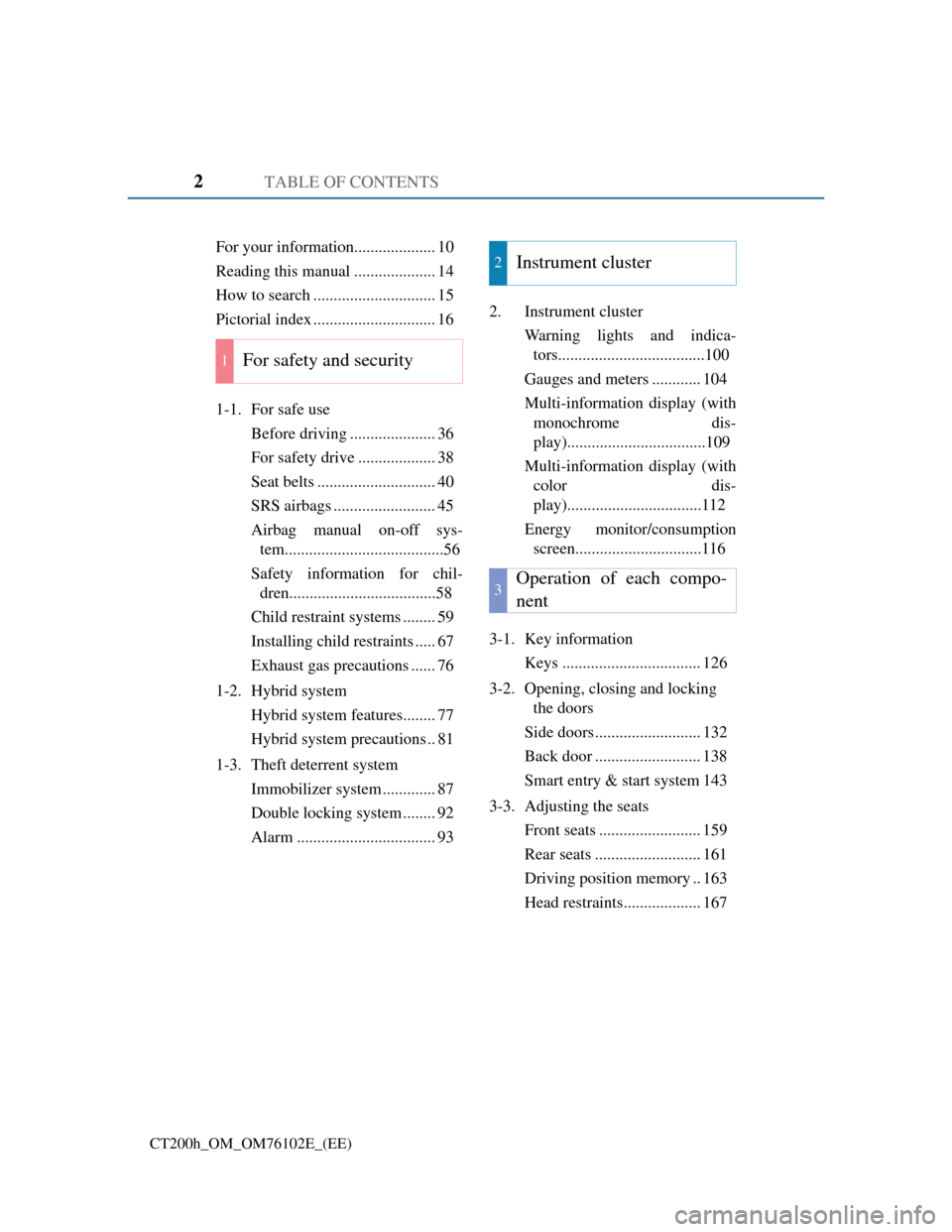
TABLE OF CONTENTS2
CT200h_OM_OM76102E_(EE)
For your information.................... 10
Reading this manual .................... 14
How to search .............................. 15
Pictorial index .............................. 16
1-1. For safe use
Before driving ..................... 36
For safety drive ................... 38
Seat belts ............................. 40
SRS airbags ......................... 45
Airbag manual on-off sys-
tem.......................................56
Safety information for chil-
dren....................................58
Child restraint systems ........ 59
Installing child restraints ..... 67
Exhaust gas precautions ...... 76
1-2. Hybrid system
Hybrid system features........ 77
Hybrid system precautions .. 81
1-3. Theft deterrent system
Immobilizer system ............. 87
Double locking system ........ 92
Alarm .................................. 932. Instrument cluster
Warning lights and indica-
tors....................................100
Gauges and meters ............ 104
Multi-information display (with
monochrome dis-
play)..................................109
Multi-information display (with
color dis-
play).................................112
Energy monitor/consumption
screen...............................116
3-1. Key information
Keys .................................. 126
3-2. Opening, closing and locking
the doors
Side doors .......................... 132
Back door .......................... 138
Smart entry & start system 143
3-3. Adjusting the seats
Front seats ......................... 159
Rear seats .......................... 161
Driving position memory .. 163
Head restraints................... 167
1For safety and security
2Instrument cluster
3Operation of each compo-
nent
Page 24 of 688
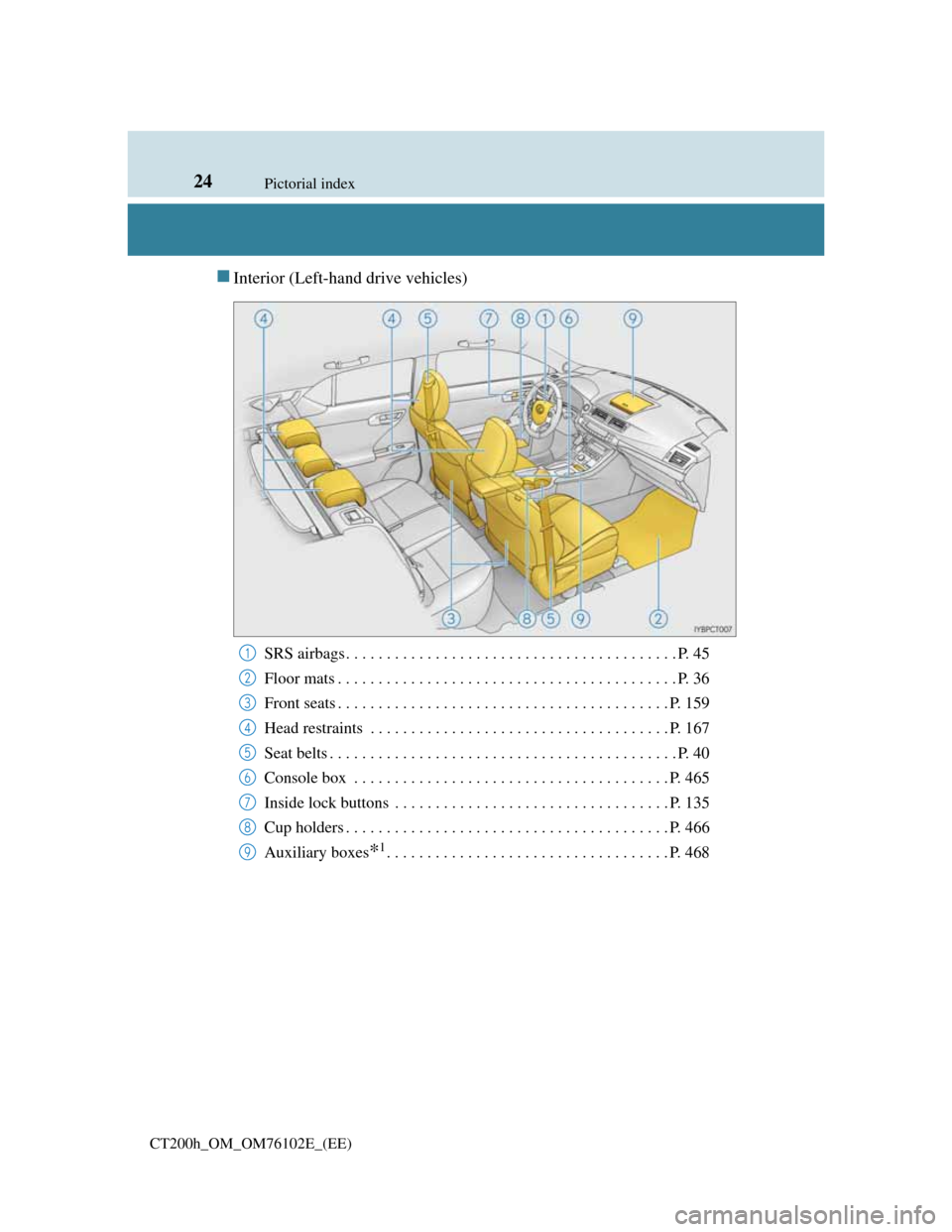
24Pictorial index
CT200h_OM_OM76102E_(EE)
Interior (Left-hand drive vehicles)
SRS airbags . . . . . . . . . . . . . . . . . . . . . . . . . . . . . . . . . . . . . . . . . P. 45
Floor mats . . . . . . . . . . . . . . . . . . . . . . . . . . . . . . . . . . . . . . . . . . P. 36
Front seats . . . . . . . . . . . . . . . . . . . . . . . . . . . . . . . . . . . . . . . . . P. 159
Head restraints . . . . . . . . . . . . . . . . . . . . . . . . . . . . . . . . . . . . . P. 167
Seat belts . . . . . . . . . . . . . . . . . . . . . . . . . . . . . . . . . . . . . . . . . . . P. 40
Console box . . . . . . . . . . . . . . . . . . . . . . . . . . . . . . . . . . . . . . . P. 465
Inside lock buttons . . . . . . . . . . . . . . . . . . . . . . . . . . . . . . . . . . P. 135
Cup holders . . . . . . . . . . . . . . . . . . . . . . . . . . . . . . . . . . . . . . . . P. 466
Auxiliary boxes
*1. . . . . . . . . . . . . . . . . . . . . . . . . . . . . . . . . . . P. 468
1
2
3
4
5
6
7
8
9
Page 32 of 688
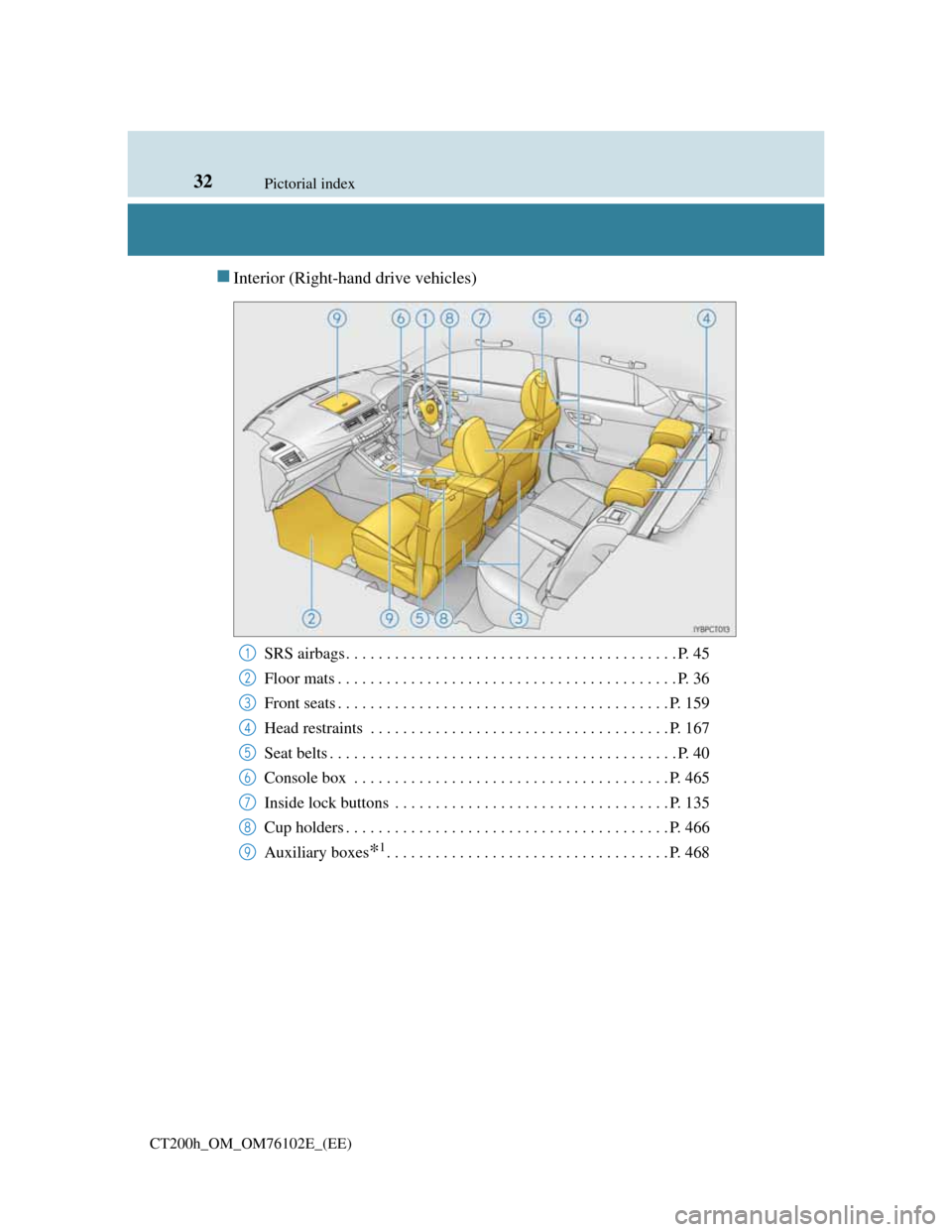
32Pictorial index
CT200h_OM_OM76102E_(EE)
Interior (Right-hand drive vehicles)
SRS airbags . . . . . . . . . . . . . . . . . . . . . . . . . . . . . . . . . . . . . . . . . P. 45
Floor mats . . . . . . . . . . . . . . . . . . . . . . . . . . . . . . . . . . . . . . . . . . P. 36
Front seats . . . . . . . . . . . . . . . . . . . . . . . . . . . . . . . . . . . . . . . . . P. 159
Head restraints . . . . . . . . . . . . . . . . . . . . . . . . . . . . . . . . . . . . . P. 167
Seat belts . . . . . . . . . . . . . . . . . . . . . . . . . . . . . . . . . . . . . . . . . . . P. 40
Console box . . . . . . . . . . . . . . . . . . . . . . . . . . . . . . . . . . . . . . . P. 465
Inside lock buttons . . . . . . . . . . . . . . . . . . . . . . . . . . . . . . . . . . P. 135
Cup holders . . . . . . . . . . . . . . . . . . . . . . . . . . . . . . . . . . . . . . . . P. 466
Auxiliary boxes
*1. . . . . . . . . . . . . . . . . . . . . . . . . . . . . . . . . . . P. 468
1
2
3
4
5
6
7
8
9
Page 38 of 688
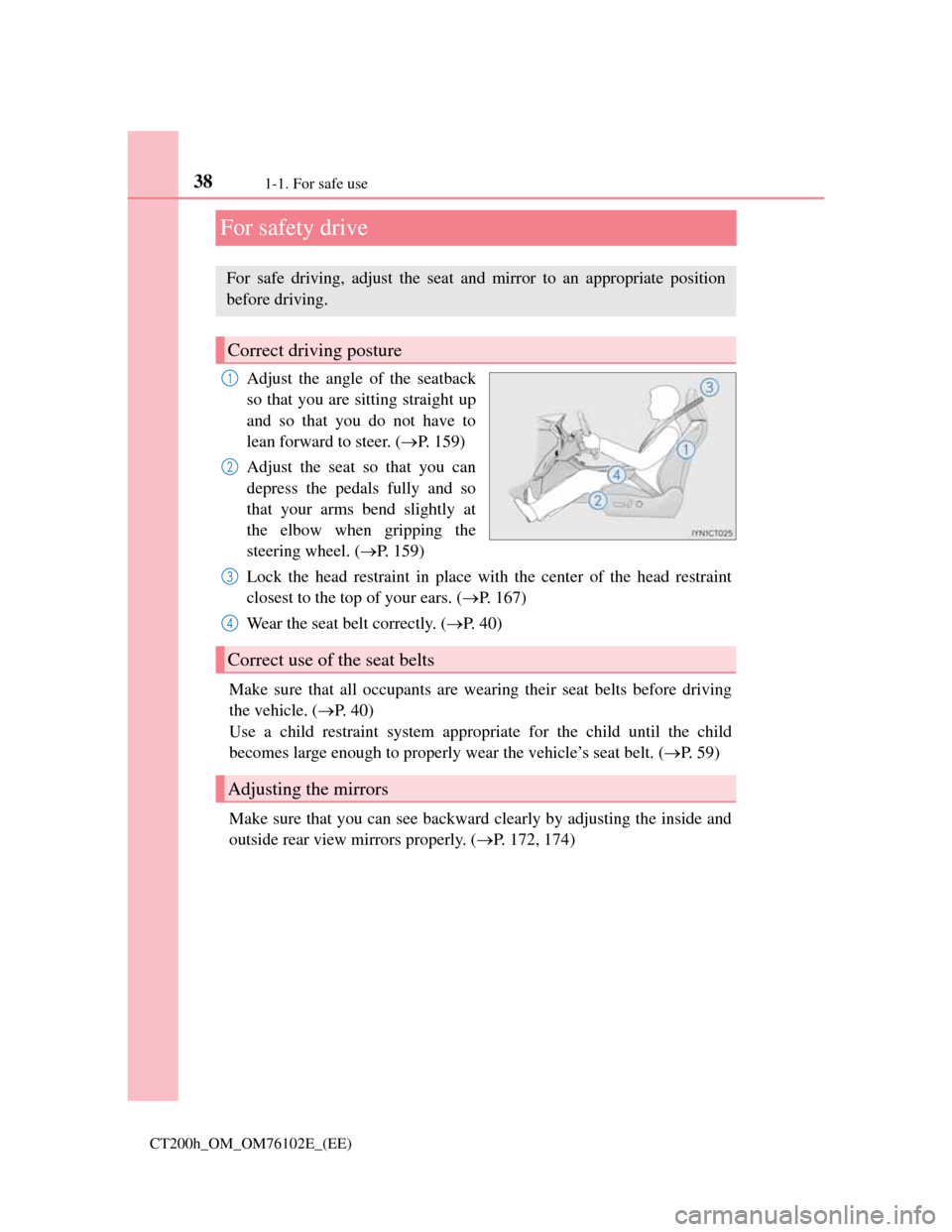
381-1. For safe use
CT200h_OM_OM76102E_(EE)
For safety drive
Adjust the angle of the seatback
so that you are sitting straight up
and so that you do not have to
lean forward to steer. (P. 1 5 9 )
Adjust the seat so that you can
depress the pedals fully and so
that your arms bend slightly at
the elbow when gripping the
steering wheel. (P. 159)
Lock the head restraint in place with the center of the head restraint
closest to the top of your ears. (P. 167)
Wear the seat belt correctly. (P. 40)
Make sure that all occupants are wearing their seat belts before driving
the vehicle. (P. 4 0 )
Use a child restraint system appropriate for the child until the child
becomes large enough to properly wear the vehicle’s seat belt. (P. 5 9 )
Make sure that you can see backward clearly by adjusting the inside and
outside rear view mirrors properly. (P. 172, 174)
For safe driving, adjust the seat and mirror to an appropriate position
before driving.
Correct driving posture
1
2
Correct use of the seat belts
Adjusting the mirrors
3
4
Page 39 of 688
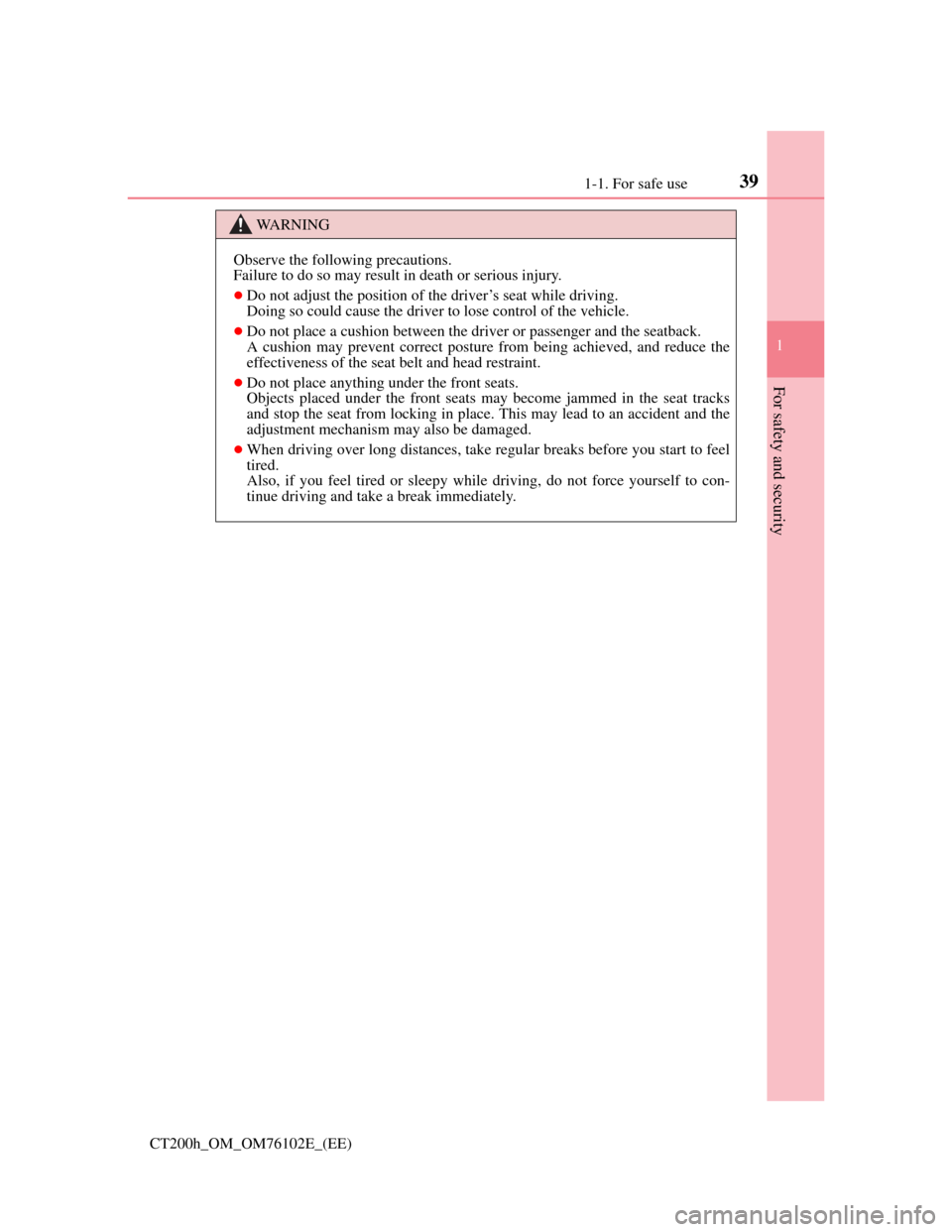
391-1. For safe use
1
CT200h_OM_OM76102E_(EE)
For safety and security
WA R N I N G
Observe the following precautions.
Failure to do so may result in death or serious injury.
Do not adjust the position of the driver’s seat while driving.
Doing so could cause the driver to lose control of the vehicle.
Do not place a cushion between the driver or passenger and the seatback.
A cushion may prevent correct posture from being achieved, and reduce the
effectiveness of the seat belt and head restraint.
Do not place anything under the front seats.
Objects placed under the front seats may become jammed in the seat tracks
and stop the seat from locking in place. This may lead to an accident and the
adjustment mechanism may also be damaged.
When driving over long distances, take regular breaks before you start to feel
tired.
Also, if you feel tired or sleepy while driving, do not force yourself to con-
tinue driving and take a break immediately.
Page 47 of 688
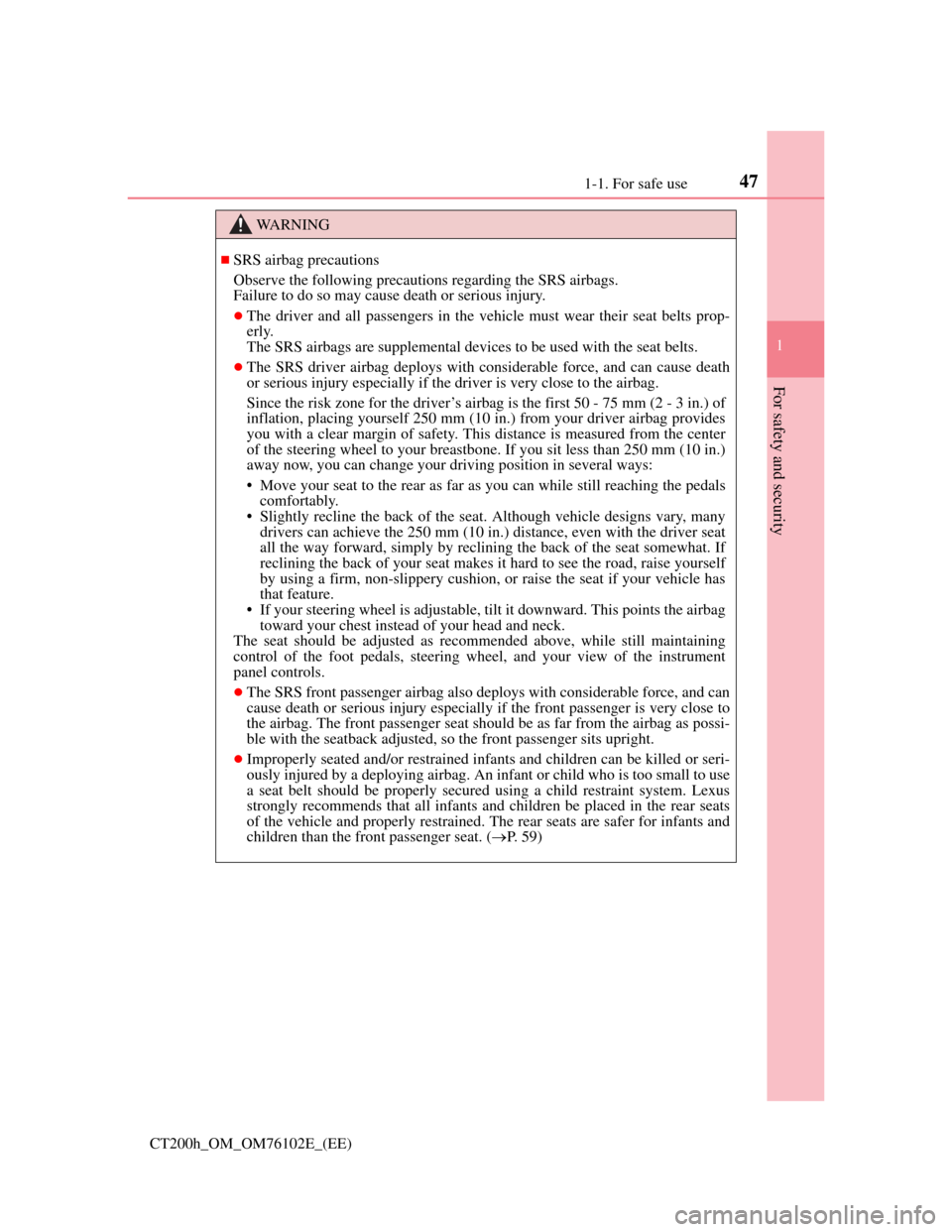
471-1. For safe use
1
CT200h_OM_OM76102E_(EE)
For safety and security
WA R N I N G
SRS airbag precautions
Observe the following precautions regarding the SRS airbags.
Failure to do so may cause death or serious injury.
The driver and all passengers in the vehicle must wear their seat belts prop-
erly.
The SRS airbags are supplemental devices to be used with the seat belts.
The SRS driver airbag deploys with considerable force, and can cause death
or serious injury especially if the driver is very close to the airbag.
Since the risk zone for the driver’s airbag is the first 50 - 75 mm (2 - 3 in.) of
inflation, placing yourself 250 mm (10 in.) from your driver airbag provides
you with a clear margin of safety. This distance is measured from the center
of the steering wheel to your breastbone. If you sit less than 250 mm (10 in.)
away now, you can change your driving position in several ways:
• Move your seat to the rear as far as you can while still reaching the pedals
comfortably.
• Slightly recline the back of the seat. Although vehicle designs vary, many
drivers can achieve the 250 mm (10 in.) distance, even with the driver seat
all the way forward, simply by reclining the back of the seat somewhat. If
reclining the back of your seat makes it hard to see the road, raise yourself
by using a firm, non-slippery cushion, or raise the seat if your vehicle has
that feature.
• If your steering wheel is adjustable, tilt it downward. This points the airbag
toward your chest instead of your head and neck.
The seat should be adjusted as recommended above, while still maintaining
control of the foot pedals, steering wheel, and your view of the instrument
panel controls.
The SRS front passenger airbag also deploys with considerable force, and can
cause death or serious injury especially if the front passenger is very close to
the airbag. The front passenger seat should be as far from the airbag as possi-
ble with the seatback adjusted, so the front passenger sits upright.
Improperly seated and/or restrained infants and children can be killed or seri-
ously injured by a deploying airbag. An infant or child who is too small to use
a seat belt should be properly secured using a child restraint system. Lexus
strongly recommends that all infants and children be placed in the rear seats
of the vehicle and properly restrained. The rear seats are safer for infants and
children than the front passenger seat. (P. 59)
Page 62 of 688

621-1. For safe use
CT200h_OM_OM76102E_(EE)
Key of letters inserted in the above table:
U: Suitable for “universal” category child restraint system approved for
the use in this mass group.
UF: Suitable for forward facing “universal” category child restraint sys-
tem approved for the use in this mass group.
L1: Suitable for “LEXUS G 0+, BABY SAFE PLUS” (0 to 13 kg [0 to
28 lb.]) approved for the use in this mass group.
L2: Suitable for “LEXUS G 0+, BABY SAFE PLUS with SEAT BELT
FIXATION, BASE PLATFORM” (0 to 13 kg [0 to 28 lb.]) approved
for the use in this mass group.
L3: Suitable for “LEXUS DUO+” (without ISOFIX, 9 to 18 kg [20 to
39 lb.]) approved for the use in this mass group.
L4: Suitable for “LEXUS KID” (15 to 36 kg [34 to 79 lb.]) approved for
the use in this mass group.
L5: Suitable for “LEXUS KIDFIX” (15 to 36 kg [34 to 79 lb.]) approved
for the use in this mass group.
X: Not suitable seat position for children in this mass group.
*1: When you use a child restraint system in this position, adjust the seat back and
fix it at the most upright lock position.
*2: When you use a child restraint system in this position, remove the head
restraint.
Other child restraint system which is different from the system mentioned
in the table can be used.
But the suitability of the systems must be carefully checked with the child
restraint system manufacturer concerned and the seller of those seats.
Page 64 of 688
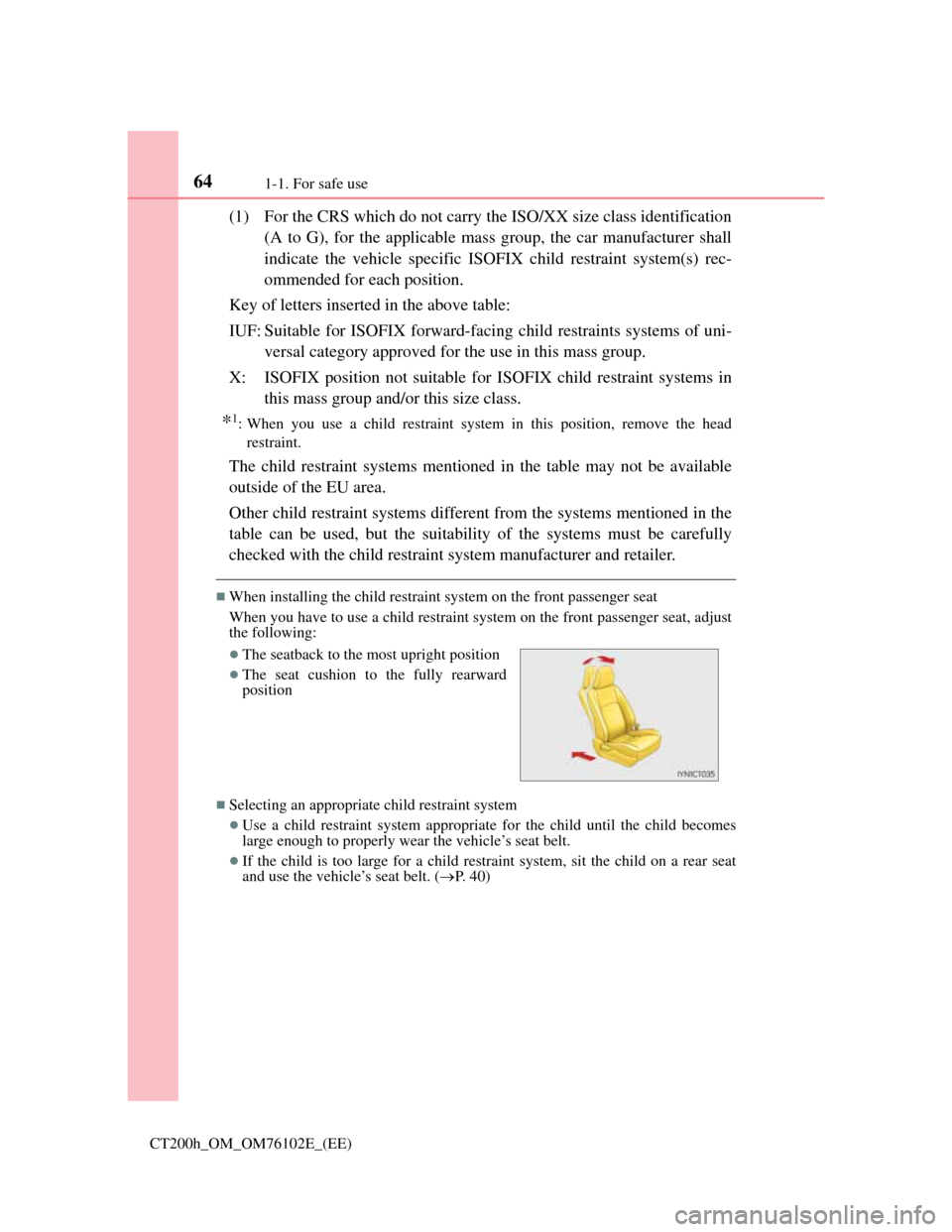
641-1. For safe use
CT200h_OM_OM76102E_(EE)
(1) For the CRS which do not carry the ISO/XX size class identification
(A to G), for the applicable mass group, the car manufacturer shall
indicate the vehicle specific ISOFIX child restraint system(s) rec-
ommended for each position.
Key of letters inserted in the above table:
IUF: Suitable for ISOFIX forward-facing child restraints systems of uni-
versal category approved for the use in this mass group.
X: ISOFIX position not suitable for ISOFIX child restraint systems in
this mass group and/or this size class.
*1: When you use a child restraint system in this position, remove the head
restraint.
The child restraint systems mentioned in the table may not be available
outside of the EU area.
Other child restraint systems different from the systems mentioned in the
table can be used, but the suitability of the systems must be carefully
checked with the child restraint system manufacturer and retailer.
When installing the child restraint system on the front passenger seat
When you have to use a child restraint system on the front passenger seat, adjust
the following:
Selecting an appropriate child restraint system
Use a child restraint system appropriate for the child until the child becomes
large enough to properly wear the vehicle’s seat belt.
If the child is too large for a child restraint system, sit the child on a rear seat
and use the vehicle’s seat belt. (P. 40)
The seatback to the most upright position
The seat cushion to the fully rearward
position
Page 65 of 688
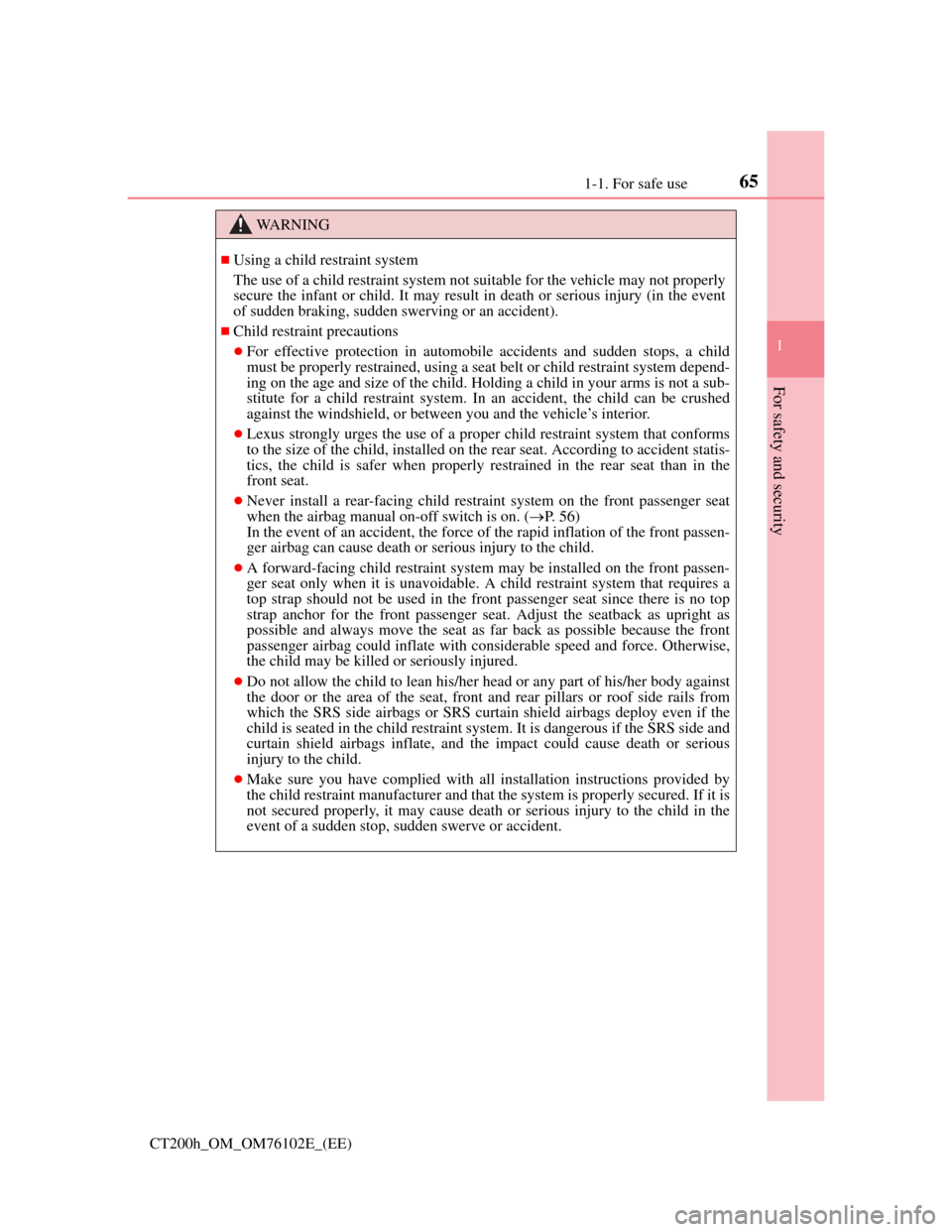
651-1. For safe use
1
CT200h_OM_OM76102E_(EE)
For safety and security
WA R N I N G
Using a child restraint system
The use of a child restraint system not suitable for the vehicle may not properly
secure the infant or child. It may result in death or serious injury (in the event
of sudden braking, sudden swerving or an accident).
Child restraint precautions
For effective protection in automobile accidents and sudden stops, a child
must be properly restrained, using a seat belt or child restraint system depend-
ing on the age and size of the child. Holding a child in your arms is not a sub-
stitute for a child restraint system. In an accident, the child can be crushed
against the windshield, or between you and the vehicle’s interior.
Lexus strongly urges the use of a proper child restraint system that conforms
to the size of the child, installed on the rear seat. According to accident statis-
tics, the child is safer when properly restrained in the rear seat than in the
front seat.
Never install a rear-facing child restraint system on the front passenger seat
when the airbag manual on-off switch is on. (P. 5 6 )
In the event of an accident, the force of the rapid inflation of the front passen-
ger airbag can cause death or serious injury to the child.
A forward-facing child restraint system may be installed on the front passen-
ger seat only when it is unavoidable. A child restraint system that requires a
top strap should not be used in the front passenger seat since there is no top
strap anchor for the front passenger seat. Adjust the seatback as upright as
possible and always move the seat as far back as possible because the front
passenger airbag could inflate with considerable speed and force. Otherwise,
the child may be killed or seriously injured.
Do not allow the child to lean his/her head or any part of his/her body against
the door or the area of the seat, front and rear pillars or roof side rails from
which the SRS side airbags or SRS curtain shield airbags deploy even if the
child is seated in the child restraint system. It is dangerous if the SRS side and
curtain shield airbags inflate, and the impact could cause death or serious
injury to the child.
Make sure you have complied with all installation instructions provided by
the child restraint manufacturer and that the system is properly secured. If it is
not secured properly, it may cause death or serious injury to the child in the
event of a sudden stop, sudden swerve or accident.
Page 69 of 688
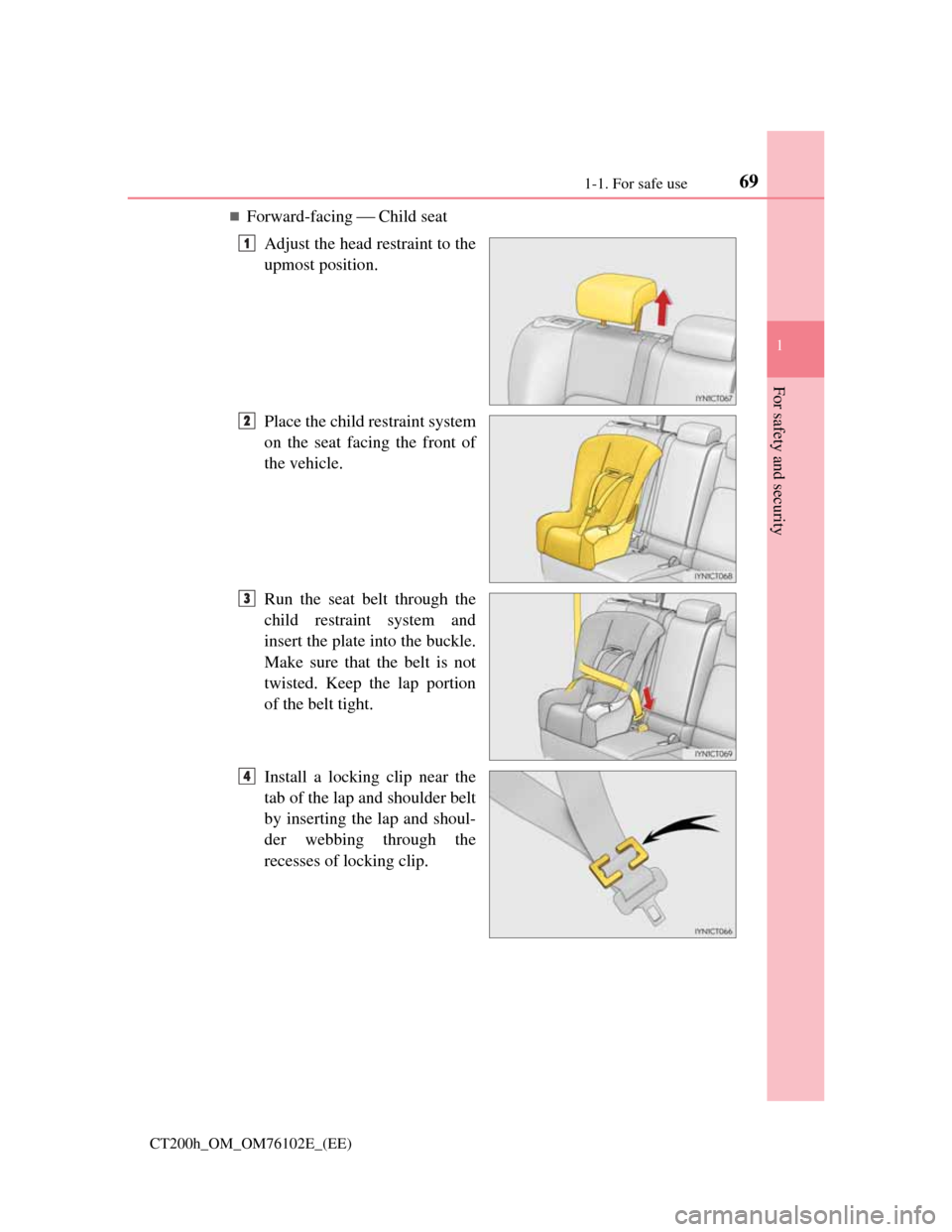
691-1. For safe use
1
CT200h_OM_OM76102E_(EE)
For safety and security
Forward-facing Child seat
Adjust the head restraint to the
upmost position.
Place the child restraint system
on the seat facing the front of
the vehicle.
Run the seat belt through the
child restraint system and
insert the plate into the buckle.
Make sure that the belt is not
twisted. Keep the lap portion
of the belt tight.
Install a locking clip near the
tab of the lap and shoulder belt
by inserting the lap and shoul-
der webbing through the
recesses of locking clip.
1
2
3
4